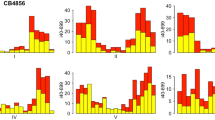Summary
The genomic DNA of two closely related strains of the nematode, Caenorhabditis elegans, Bristol (N2), and Bergerac (Bo), has different restriction endonuclease sites (Emmons et al. 1979). Since these two strains interbreed, it is possible to regard the restriction fragment length differences (RFLDs) as mutant variants. The N2 and Bo pattern can be segregated and mapped using clasical genetic techniques.
Utilizing a number of genetic markers existing in the N2 strain, we have constructed hybrid populations homozygous for either Bristol or Bergerac over a given chromosomal region with random Bristol-Bergerac composition for the remainder of the genome. Genomic restriction digests from these hybrid populations were probed with random cloned fragments of Bristol DNA. In this way, fragments were mapped to genetically well characterized regions of the C. elegans genome. 27 probes which hybridize to a total of 310 Kb of DNA were found to exhibit six restriction fragment differences. Four of these differences have been mapped, providing probes for four different genomic regions. We have combined classical genetics and recombinant DNA technology to construct linkage maps of cloned DNA fragments using restriction fragment length differences. We are pursuing this approach in order to advance the knowledge of the genetic organization of C. elegans and to provide a means of cloning genes in an organism which provides an experimental model for the study of many biological systems. It is hoped that this approach will also provide a practical solution to some difficult problems in nematode strain identification. Furthermore, the characterization of the families of transposable elements responsible for generating many of the RFLDs will undoubtedly contribute to the understanding of the biological significance of these elements.
Similar content being viewed by others
References
Brenner S (1974) The genetics of Caenorhabditis elegans. Genetics 77:71–94
Botstein D, White RL, Skolnick M, Davis RW (1980) Construction of a genetic linkage map in man using restriction fragment length polymorphisms. Am J Hum Genet 32:314–331
Butler MH, Wall SM, Luehrsen KR, Fox GE, Hecht RM (1981) Molecular relationships between closely related strains and species of nematodes. J Mol Evans 18:18–23
Davis RW, Botstein D, Roth JR (1980) A manual for genetic engineering: advanced bacterial genetics. Cold Spring Harbor Laboratory, New York
Emmons SW, Klass MR, Hirsh D (1979) Analysis of the constancy of DNA sequences during development and the evolution of the nematode Caenorhabdits elegans. Proc Natl Acad Sci USA 76:1333–1337
Guerry P, Leblanc DJ, Falkow S (1979) In: Wu R (ed) Methods in enzymology, vol 68, Recombinant DNA. Academic Press, New York, p 270
Horvitz HR, Brenner S, Hodgkins J, Herman RK (1979) A uniform genetic nomenclature for the nematode Caenorhabditis elegans. Genetics 86:275–287
Kan YM, Dozy AM (1978) Polymorphism of DNA sequence adjacent to human β-globin structural gene: relationship to sickle mutation. Proc Natl Acad Sci USA 75:5631–5635
Langridge J, Langridge P, Berquist PL (1980) Extraction of DNA from agarose gels. Anal Biochem 103:264–271
MacLeod AR, Karn J, Brenner S (1981) Molecular analysis of the unc-54 myosin heavy chain gene of Caenorhabditis elegans. Nature 291:386–390
Mandel M, Higa A (1979) In: Wu R (ed) Methods in enzymology, vol 68, Recombinant DNA. Academic Press, New York, p 252
Maniatas T, Jeffrey A, Kleid DG (1975) Nucleotide sequence of the rightward operator of phage. Proc Natl Acad Sci USA 72:1184–1188
Olson MV, Loughney K, Hall BD (1979) Identification of the yeast DNA sequences that correspond to specific tyrosine-inserting nonsense suppressor loci. J Mol Biol 132:387–410
Petes TK, Botstein D (1977) Simple Mendelian inheritance of the reiterated ribosomal DNA of yeast. Proc Natl Acad Sci USA 74:5091–5095
Smith GE, Summers MD (1980) The bidirectional transfer of DNA and RNA to nitrocellulase or DBM paper. Anal Biochem 109:123–129
Solomon E, Bodmer WF (1979) Evolution of sickle variant gene. Lancet I:923
Southern EM (1975) Detection of specific sequences among DNA fragments separated by gel electrophoesis. J Mol Biol 98:503–517
Sulston JE, Brenner S (1974) The DNA of Caenorhabditis elegans. Genetics 77:95–104
Riddle DL (1978) The genetics of development and behavior in Caenorhabditis elegans. J Nematol 10:1–16
Rosenbluth RE, Baillie DL (1981) The genetic analysis of a reciprocal translocation, eT1 (III: V), in Caenorhabditis elegans. Genetics 99:415–428
Zuckerman BM (ed) (1980) Nematodes as biological models Academic Press, New York
Author information
Authors and Affiliations
Additional information
Communicated by M.M. Green
Rights and permissions
About this article
Cite this article
Rose, A.M., Baillie, D.L., Candido, E.P.M. et al. The linkage mapping of cloned restriction fragment length differences in Caenorabditis elegans . Mol Gen Genet 188, 286–291 (1982). https://doi.org/10.1007/BF00332689
Received:
Issue Date:
DOI: https://doi.org/10.1007/BF00332689




